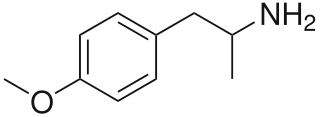
3,4-Methylenedioxymethamphetamine (MDMA), commonly known as ecstasy (E) or molly, is a psychoactive drug primarily used for recreational purposes. The desired effects include altered sensations, increased energy, empathy, as well as pleasure. When taken by mouth, effects begin in 30 to 45 minutes and last 3 to 6 hours.

Empathogens or entactogens are a class of psychoactive drugs that produce experiences of emotional communion, oneness, relatedness, emotional openness—that is, empathy or sympathy—as particularly observed and reported for experiences with 3,4-methylenedioxymethamphetamine (MDMA). This class of drug is distinguished from the classes of hallucinogen or psychedelic, and amphetamine or stimulant. Major members of this class include MDMA, MDA, MDEA, MDOH, MBDB, 6-APB, methylone, mephedrone, αMT, and αET, MDAI among others. Most entactogens are phenethylamines and amphetamines, although several, such as αMT and αET, are tryptamines. When referring to MDMA and its counterparts, the term MDxx is often used. Entactogens are sometimes incorrectly referred to as hallucinogens or stimulants, although many entactogens such as ecstasy exhibit psychedelic or stimulant properties as well.

3,4-Methylenedioxyamphetamine (MDA), known commonly as sass, is an empathogen-entactogen, psychostimulant, and psychedelic drug of the amphetamine family that is encountered mainly as a recreational drug. In terms of pharmacology, MDA acts most importantly as a serotonin-norepinephrine-dopamine releasing agent (SNDRA). In most countries, the drug is a controlled substance and its possession and sale are illegal.

para-Methoxyamphetamine, also known as 4-methoxyamphetamine (4-MA), is a designer drug of the amphetamine class with serotonergic effects. Unlike other similar drugs of this family, PMA does not produce stimulant, euphoriant, or entactogen effects, and behaves more like an antidepressant in comparison, though it does have some psychedelic properties.

4-Methylthioamphetamine (4-MTA) is a designer drug of the substituted amphetamine class developed in the 1990s by a team led by David E. Nichols, an American pharmacologist and medical chemist, at Purdue University. It acts as a non-neurotoxic highly selective serotonin releasing agent (SSRA) in animals. 4-MTA is the methylthio derivative of amphetamine.

Hydrastinine is a semisynthetic alkaloid from the hydrolysis of the alkaloid hydrastine, which was found naturally in small quantities in Hydrastis canadensis L. (Ranunculaceae). Hydrastinine was produced by oxidative splitting of hydrastine hydrochloride with nitric acid in good yield. The drug was patented by Bayer as a haemostatic drug during the 1910s.

5-Methoxy-3,4-methylenedioxymethamphetamine is a designer drug of the substituted methylenedioxyphenethylamine (MDxx) class. Little is known about its effects and it has not been formally studied in animals.

1,3-Benzodioxolylbutanamine is an entactogenic drug of the phenethylamine chemical class. It is the α-ethyl analog of MDPEA and MDA and the methylenedioxy analogue of α-ethylphenethylamine.

para-Chloroamphetamine (PCA), also known as 4-chloroamphetamine (4-CA), is a substituted amphetamine and monoamine releaser similar to MDMA, but with substantially higher neurotoxicity, thought to be due to the unrestrained release of both serotonin and dopamine by a metabolite. It is used as a neurotoxin by neurobiologists to selectively kill serotonergic neurons for research purposes, in the same way that 6-hydroxydopamine is used to kill dopaminergic neurons.

MDAI (5,6-methylenedioxy-2-aminoindane) is a drug developed in the 1990s by a team led by David E. Nichols at Purdue University. It acts as a non-neurotoxic and highly selective serotonin releasing agent (SSRA) in vitro and produces entactogen effects in humans.

A monoamine releasing agent (MRA), or simply monoamine releaser, is a drug that induces the release of a monoamine neurotransmitter from the presynaptic neuron into the synapse, leading to an increase in the extracellular concentrations of the neurotransmitter. Many drugs induce their effects in the body and/or brain via the release of monoamine neurotransmitters, e.g., trace amines, many substituted amphetamines, and related compounds.

SR-142948 is a drug used in scientific research which is a non-peptide antagonist selective for the neurotensin receptors, although not selective between subtypes.
The molecular formula C11H15NO2 (molar mass : 193.24 g/mol, exact mass : 193.110279) may refer to:
A serenic, or antiaggressive agent, is a type of drug which reduces the capacity for irritability and aggression.

α-Methyldopamine (α-Me-DA), also known as 3,4-dihydroxyamphetamine, is a research chemical of the catecholamine and amphetamine chemical classes. Its bis-glutathionyl metabolite is slightly neurotoxic when directly injected into the brain's ventricles.

3,4-Dimethoxy-N-methylamphetamine (DMMA) is a psychoactive drug and research chemical of the phenethylamine and amphetamine chemical classes. It appears to act as a serotonin-norepinephrine-dopamine releasing agent (SNDRA), although it is significantly less potent than MDMA.

Difluoromethylenedioxyamphetamine (DiFMDA) is a substituted derivative of 3,4-methylenedioxyamphetamine (MDA), which was developed by Daniel Trachsel and coworkers, along with the corresponding fluorinated derivatives of MDMA, MDEA, BDB and MBDB, with the aim of finding a non-neurotoxic drug able to be used as a less harmful substitute for entactogenic drugs such as MDMA. Since a major route of the normal metabolism of these compounds is scission of the methylenedioxy ring, producing neurotoxic metabolites such as alpha-methyldopamine, it was hoped that the difluoromethylenedioxy bioisostere would show increased metabolic stability and less toxicity.

UWA-101 is a phenethylamine derivative invented at the University of Western Australia and researched as a potential treatment for Parkinson's disease. Its chemical structure is very similar to that of the illegal drug MDMA, the only difference being the replacement of the α-methyl group with an α-cyclopropyl group. MDMA has been found in animal studies and reported in unauthorised human self-experiments to be effective in the short-term relief of Parkinson's disease symptoms, especially when used alongside conventional treatment with L-DOPA. However the illegal status of MDMA and concerns about its potential for recreational use, neurotoxicity and potentially dangerous side effects mean that it is unlikely to be investigated for medical use in this application, and so alternative analogues were investigated.

2,4,5-Trihydroxymethamphetamine (THMA) is a neurotoxin and a metabolite of MDMA. It has structural similarity to the dopamine neurotoxin 6-hydroxydopamine, and produces lasting serotonin deficits when administered centrally.

2,3-Methylenedioxymethamphetamine (2,3-MDMA) is a positional isomer of the recreational drug 3,4-MDMA.


















